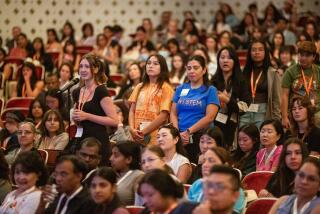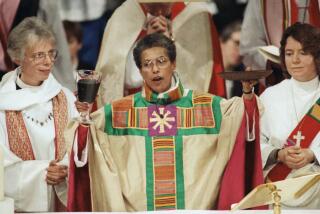Notre Dame Celebrates 25 Years of Coeducation
- Share via
SOUTH BEND, Ind. — The gym was packed with young men when Shayla Keough Rumely arrived for physical education class as a freshman at the University of Notre Dame.
Everywhere she looked, there were dozens of them. Some were playing basketball, others just stood around talking. There were so many of them, and she and her friend couldn’t see any other women.
Actually, some other women were there, and Rumely and her friend eventually found them. The awkward moment passed, though there would be others. That was just part of life at Notre Dame in the fall of 1972, when a small group of women joined what, up until then, had been an all-male world.
“We were all aware this was an unusual time,” Rumely said. “I honestly think we were so lucky to be there and be in that situation. . . . I’m very, very glad that I did it.”
Now, 25 years later, Notre Dame is a very different place. Women make up 45% of the 7,800 students. The school’s last national championship was won by the women’s soccer team two years ago. The president-elect of the alumni association is a woman.
It’s exactly what the Rev. Theodore Hesburgh hoped for when he decided to abandon Notre Dame’s 130-year tradition of all-male education.
Hesburgh, who had three sisters, had wanted to make Notre Dame coed since shortly after he took over as president in 1952. But he dropped the idea because he knew the majority of students wouldn’t support it.
“I used to think it was like a zoo,” he said of the all-male campus. “That’s probably overstating, but it gets a little rough when you have all men living together.
“We can’t run the country on men alone, never could,” he added. “Women ought to have the same opportunities to develop their talents as men do.”
By 1970, the country was going through major social changes, and Hesburgh decided the time might finally be right to bring women to Notre Dame. Some students from St. Mary’s College were already taking classes there as part of a co-exchange program that began in 1965.
So he approached the nuns at St. Mary’s, located just across the road, about a merger. Talks went back and forth, and the merger was on, off, then on again.
“Finally I said, ‘Sisters, . . . I get the impression, because you’ve been talking to us for two years, that you want to marry us, but you don’t want to take our name and you don’t want to live with us,’ ” Hesburgh recalled. “They said, ‘That’s exactly it.’ I said that’s not what we want and that’s not what we’re interested in, so why don’t we agree to disagree.”
On Nov. 30, 1971, the schools announced they weren’t merging. At the same time, Notre Dame announced it would begin admitting women, starting with a small group the next fall.
Rumely remembers getting the letter asking if she wanted her application to go to Notre Dame, St. Mary’s or both. She checked Notre Dame.
“I thought, ‘What a fabulous opportunity,’ ” she said. “The opportunity to be one of the pioneers really sealed the deal for me.”
The 365 women admitted that first fall made up just 5% of the student body. There were 125 freshmen and 240 transfers, mostly from St. Mary’s.
It was a huge change for the male students, but not for the reasons most people would think, said Michael Garvey, a university spokesman who was a junior in 1972.
The co-exchange program had made Notre Dame seem like a coed school, he said. In a class of 20 students, Garvey said there usually were eight or nine women. But when Notre Dame went coed, the women disappeared.
“The St. Mary’s women went back across the road and a much, much smaller number of women who had been admitted to the University of Notre Dame showed up,” Garvey said. “Once we became coeducational, I never saw any women.”
Rumely doesn’t recall any hostility from the male students, though there were plenty of awkward moments. Most classes had just one or two women. Male students would sometimes hold up rating cards when women walked into the dining hall.
And there were teachers who didn’t know how to deal with women in their classrooms, said Sister Jean Lenz, the rectress at Farley Hall when it became a women’s dorm in 1973.
“One professor . . . asked what I called them. He was calling [male students] Mr., like Mr. Jones, but he wasn’t sure what to call the women,” she said. “I said, ‘I tend to call them by their first names.’ ”
Rumely said Hesburgh deserves much of the credit for the relatively smooth transition. He made it clear to everyone that he supported coeducation and was going to do everything he could to make it work, she said.
At a Mass for freshmen and their parents the first weekend, Rumely remembers Hesburgh looking up at the statue of Mary on the university’s famed golden dome and saying, “I just apologize it’s taken so many years to welcome your daughters.”
“That was the tone,” Rumely said. “[He] was our greatest support.”
Hesburgh expected some resistance from alumni, and was pleasantly surprised when there was very little.
“The alumni don’t just have sons, the alumni have daughters,” he said. “And some guys, their sons couldn’t get in, but their daughters could.”
The growing pains continued as the number of women on campus slowly caught up to the men. By 1992--20 years after the first class of women was admitted--women made up roughly 45% of the student body, and that number has held steady since then.
Rumely takes great pride in the changes she’s seen at Notre Dame--changes she and her classmates helped bring about.
“My impression is women have raised the standards,” she said. “I’m very proud, very proud of what the women have done for Notre Dame. And I’m very proud of Notre Dame for doing it.”
More to Read
Get our high school sports newsletter
Prep Rally is devoted to the SoCal high school sports experience, bringing you scores, stories and a behind-the-scenes look at what makes prep sports so popular.
You may occasionally receive promotional content from the Los Angeles Times.






